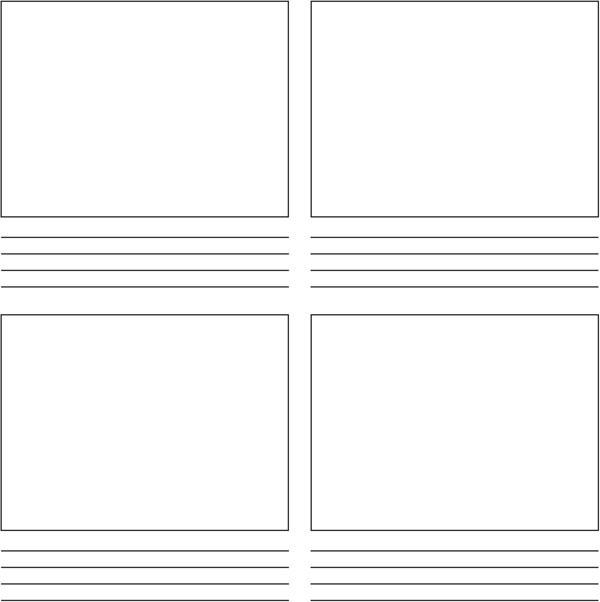Create To Communicate
Create To Communicate
LESSON 2
TRANSPORTATION
Planes, Trains, and Automobiles
Objective: Students will write about an imaginary trip and draw pictures in a comic strip format using transportation vocabulary and past tense.
Level: High Beginner to Low Intermediate
Materials: Required: paper and pencils. Optional: crayons, colored pencils, or markers.
Teacher Preparation: 1. If possible, duplicate the template in the Reproducible Worksheet section of this activity. (Groups may need more than one sheet to draw their story.) 2. Cut out strips of paper for Part One.
INSTRUCTIONS
Part One: Collaborative Comic Strip Story
- Divide students into groups of three or four.
- Tell students to imagine they are taking a trip, and elicit from them various types of transportation that could be used. Write their responses on the board. Common modes of transportation, such as cars, trains, boats, and bicycles can be included, but encourage students to be creative and think past the traditional modes of transportation to include other forms, such as hot air balloons, hang gliders, parachutes, roller blades, submarines, or rocket ships.
Possible Modes of Transportationcar
airplane
train
donkey
helicopter
horse
kayak
on foot
boat
bicycle
motorcycle
bus - As a list is generated, have one student serve as class recorder and write each mode of transportation on a small strip of paper. Fold the strips of paper in half and place them in a basket or other small container.
- Have students brainstorm various destinations. Create a list on the board.
Possible DestinationsThe Moon
The Sahara Desert
The White House
Antarctica
The Pyramids of Egypt
The Swiss Alps
An island in the South Pacific
The Amazon
The Great Wall of China
The Earth’s core - As the list of destinations is generated, have another student recorder write each destination on a small strip of paper. Fold the strips of paper in half and place them in a different basket or into a small container.
- Have one member from each group choose two strips of paper, one from the destination basket and one from the mode of transportation basket.
- Once each group has chosen two strips, the group must create a character for their story. The group will create a story about how their character uses the mode of transportation they chose, to get to the destination they chose.
- Pass out the comic strip template found at the end of this lesson (one per group). Groups may need more than one sheet to draw their story.
- Each group member should contribute to the story in some manner. Group members can help develop the story and decide on the steps of the journey, help draw the pictures in the comic boxes, or help complete both tasks.
- Below is a basic outline students can follow if they need help structuring or drawing their story. Adapt or modify the outline as needed to suit the level of the students.
a. The first box should contain a drawing of the character at the beginning of the journey.b. In the next box, students should show some aspect of the trip.c. In the following box(es), students could show any problems, people, or places the character may encounter along the trip.d. In the last box, students should show their character arriving at the destination. Ask students questions to help them imagine their destination, such as “What would you find when you arrive? What does the landscape look like? Are there lots of people? Or are there no people? Are there any animals or plants? Is anybody there to meet you?”
- If possible, have students add color to the drawings with crayons, markers, or colored pencils.
Part Two: Re-Telling the Stories with Words
- Collect the comic strip stories when all groups are finished.
- Randomly pass out different comic strips to each group, making sure the groups do not receive their own comic strip.
- Instruct the groups to look at the pictures in the comic strip boxes and write a story to accompany the pictures on the lines provided beneath the pictures.
- Have students write the stories in past tense.
- Remind students that what they write should correspond to the picture.
- When every group is finished, have each group present the comic strip pictures and read the story they wrote to the entire class.
Part Three: 3-2-1 Closing Exercise
- To review what was learned and check students’ comprehension, have students do a 3-2-1 closing exercise.
- Tell students to write
- Three key terms they learned;
- Two interesting things they found out;
- One question they still have.
- Address any common questions or concerns students expressed in the 3-2-1 exercise.
Extension Activity:
Transportation Charades
First, make a list of the different types of transportation students included in their stories and drawings. Add any additional types of transportation students brainstormed as well. Write each type or form of transportation on a card or small piece of paper. If needed, review these modes of transportation with students to make sure they know and understand the vocabulary. The completed story drawings can be referred to for examples. Next, play charades by breaking students up into pairs. Each pair takes a turn picking a card or piece of paper. The group then has to act out that mode of transportation to the class. The group cannot use words, only movements, gestures, and sounds. The first group that correctly guesses the transportation vocabulary word gets a point. The group with the most points at the end of the game wins.
Additional Resources:
Here are two Internet-powered comic book creators that work in computer lab settings:
Read, Write, Think Comic Creator
http://www.readwritethink.org/files/resources/interactives/comic/index.html
http://www.readwritethink.org/files/resources/interactives/comic/index.html
Make Beliefs Comix
http://www.makebeliefscomix.com/Comix/
http://www.makebeliefscomix.com/Comix/
COMIC STRIP STORY
Directions: Draw the pictures for your story in the boxes. Then, write sentences for each drawing on the lines below the boxes.
